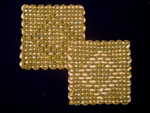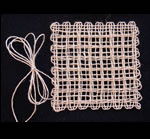I love plain weave, but a simple yarn and a very simple project might call for a something a little extra. The pattern book from Buxton Brook Looms (
www.weavettes.com) is a wonderful resource, as are the old Loomette booklets and Bucilla Dictionary of Weaving Stitches.
Don’t let the appearance of the written directions with all the O’s and U’s scare you off. Weaving patterns is much, much easier than those long directions would lead you to believe
Photographed samples in the published weave pattern books are made with yarns that are about as heavy as the looms can handle. A lightweight yarn may look dramatically different! Look at the difference in these two samples. In the Weavette book, Licia Conforti calls this “Corduroy”. I weave it in linen and call it “Windowpane Lace”. Same loom, same weave, but what a difference the yarn makes!
Weaving with more than one color of yarn adds a wonderful new dimension to textured weaving patterns, but the downside is that there are two ends to hide for every color used. Here’s a clean and neat way to finish them.

|
1. Wrap the first three layers (or two, depending on your pattern) with main yarn and then cut, leaving a 4” yarn tail. With the contrast yarn, make a loose slip knot about 4” from the cut end. |

|
2. Thread the last main yarn tail through the slipknot of the contrast yarn. |

|
3. Snug the slipknot up to the corner before gently closing it, just enough to hang on to the main yarn. (Don’t pull too hard on the knot because you will take it apart in a few minutes.) |

|
4. Measure the contrast yarn and weave the square. Weave ending contrast yarn tail to the left, back through the last row that you wove, next to the pins (color on top of same color). |

|
5. Weave in the beginning main yarn tail, up, next to the pins (bottom left corner) as usual. Undo the slipknot on bottom right corner. |

|
6. Weave in the ending main yarn tail, up, next to the pins (color on top of color). |

|
7. Weave in the beginning contrast yarn back to the left, next to the pins (color on top of color). |

|
8. Trim and done! Notice that the pattern is still rather indistinct while the weaving is stretched on the loom. |

|
9. Remove patterned weaving from the loom and the design POPS! Steam blocking adds even more dimension to this soft wool yarn. |
Interesting bonus—design colors are reversed on the back of two color patterns. This is “Double Outline Diamond” from the Weave-It Weaves booklet.
With ends neatly finished, you are free to choose any method of joining pieces and not have to worry about hiding them.















